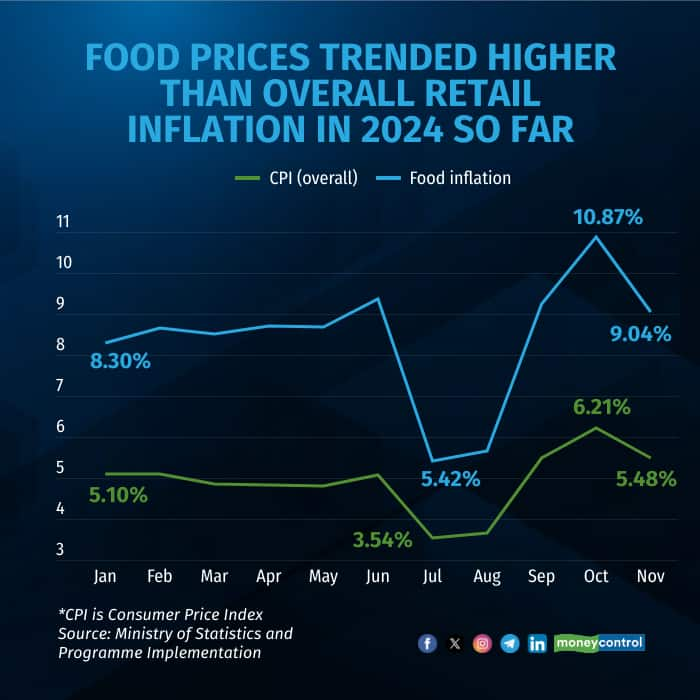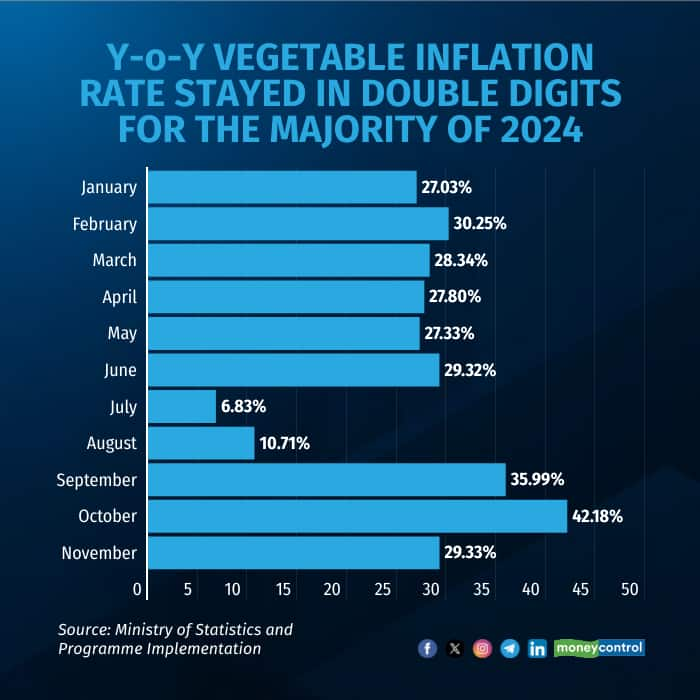



Steeper staple prices and their impact on consumption became the focal point of debates, more often than not, in 2024. While the overall headline retail inflation averaged 4.92 percent in January-November, that of food has been close to double of that at 8.41 percent.
The Consumer Price Food Index saw the steepest spike in October, at 10.87 percent, while it was at its lowest in July, at 5.42 percent, according to data available for January-November.
When it comes to overall retail inflation, the year witnessed an almost five-year low rate of 3.54 percent in July, while October witnessed the steepest rise in 2024, at 6.21 percent.
The statistics ministry, on December 12, said: “It can be observed that after December 2023, inflation rate for both CPI (general) and the food index were declining, reaching their lowest point in July 2024. However, from August 2024 to October 2024, an increasing trend was observed. Thereafter, in November 2024, inflation again declined.”
So far in 2024, another consistent trend was rural inflation. It trended higher at 5.4 percent in January-November versus its urban counterpart that saw a lower rate of 4.4 percent.

On December 6, the Reserve Bank of India (RBI) revised its inflation forecast to 4.8 percent for FY25, up from the 4.5 percent projection it had maintained until its October meeting.
Inflation exceeded the the central bank's estimate in the first half of the year and breached its upper tolerance limit of 6 percent in October, before easing to 5.5 percent last month.
Volatile vegetables
Food inflation was primarily driven up by vegetables during the 11 months of 2024. The Consumer Price Index (CPI) data for December will be released on January 12.
A closer look at the 11-month data shows that, barring July, vegetable prices stayed in double digits, with an average year-on-year (YoY) inflation rate of almost 27 percent in 2024 so far.
The steepest spike in the cost of vegetables was seen in October with the inflation rate jumping over 40 percent on-year, while July was the only month when it fell below double digits to 6.83 percent.

Take for example, the prices of tomatoes, onions and potatoes, or the ‘TOP’ vegetables. Each of them have seen a significant rise in costs, compared to the first month of 2024.
A kilogram of tomatoes cost nearly 60 percent more, on an average, as per data for November 30, compared to January 1, 2024. For potatoes and onions, the rise is almost 36 percent, and close to 67 percent, respectively, for that period.
While vegetables remained the main driver of food inflation for the majority of 2024, the perishables, with the steepest rise in retail prices, saw some change in the later months.
In fact, as per the latest data for November, garlic exhibited the highest YoY inflation rate at 85.14 percent, followed by the usual suspect, potato, at 66.65 percent and cauliflower, at 47.70 percent.
Items with the lowest inflation on-year in November 2024 included jeera (-35.04 percent), ginger (-16.96 percent).
The weightage of the food and beverages basket is around 50 percent in India’s CPI. Given this, the cost of vegetables and staples has a significant impact on the overall rate of inflation.
Consumption woes
The spike in food inflation coincided with an election year when spending by the government typically slows down, a trend seen especially in the first half of the current financial year ending March 2025.
While revenue expenditure in April-October of FY25 is slightly slower on-year at 52.7 percent of the budgeted target, spending on capital remained relatively more muted at 42 percent of the allocation of Rs 11.11 lakh crore versus 54.7 percent spent during the same period last fiscal.
This is evident from a slowdown in the GDP growth for the second quarter of the current fiscal to 5.4 percent, the lowest in seven quarters, compared with 6.7 percent in the first quarter.
In fact, after accelerating to a seven-quarter high of 7.4 percent in Q1 FY25, Private Final Consumption Expenditure or PFCE, slowed down to 6 percent during July-September. PFCE is a key indicator to measure spending incurred by households.
As per a survey by the RBI for November 2024, consumer confidence for the current period declined marginally, owing to weaker sentiments across the survey parameters, except household spending.
The current situation index moderated by 0.7 points to 94 in November 2024 as households anticipated higher spending over a one-year horizon on the back of higher essential as well as non-essential spending.
The latest round of the survey was conducted during November 2-11, 2024, covering 6,078 respondents.
Several high-frequency indicators, including sales of personal vehicles and fast-moving consumer goods (FMCGs), credit growth as well as fuel usage have been pointing at a more pronounced slowdown in urban consumption.
Take, for instance, the data for retail sales of vehicles by the Federation of Automobile Dealers Associations (FADA) since the start of the current fiscal till November 2024. Urban India has bought less two and three-wheelers than rural India.

In the two-wheeler segment, sales in rural markets sharply rose by 19.93 percent YoY in November 2024, while in urban areas, it was at a much lower 9.08 percent. A similar trend was seen in passenger vehicles as well.
Overall vehicle sales in November 2024 jumped 16.53 percent in rural areas, whereas growth remained at a significantly smaller 3.66 percent in urban India.
Auto sales are among the key indicators used to assess India's private consumption.
Finance Minister Nirmala Sitharaman recently weighed in on the debate on inflation and consumption, citing that the headline retail rate was brought back to 5.1 percent during 2014-2024, after it had touched double-digit figures during the previous Congress-led regime.
"The Centre is committed to better managing food inflation where volatility in certain food items is weather-driven," she said, while advocating for capex over cash transfers to boost consumption.
Going ahead, most economists see food prices easing in the coming weeks with the arrival of kharif crops. This would, in turn, lead to a pickup in demand, albeit more from rural India than urban.
Discover the latest Business News, Sensex, and Nifty updates. Obtain Personal Finance insights, tax queries, and expert opinions on Moneycontrol or download the Moneycontrol App to stay updated!
Find the best of Al News in one place, specially curated for you every weekend.
Stay on top of the latest tech trends and biggest startup news.